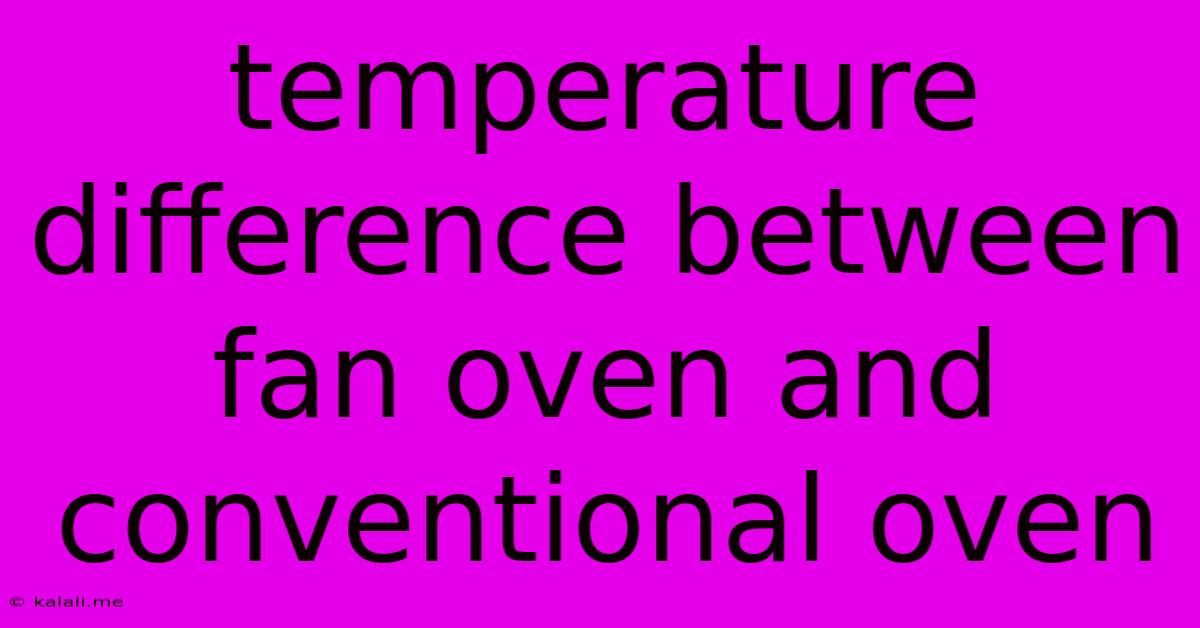Temperature Difference Between Fan Oven And Conventional Oven
Kalali
May 22, 2025 · 3 min read

Table of Contents
Fan Oven vs. Conventional Oven: Understanding the Temperature Difference
Are you confused about the temperature difference between a fan oven and a conventional oven? Many home cooks find themselves wrestling with slightly burnt dishes or undercooked pastries, often due to the subtle but significant differences in how these ovens distribute heat. This article will clarify the core distinctions and offer tips for achieving perfect results in both.
Understanding the Heating Mechanisms
The primary difference lies in the heating element and air circulation. A conventional oven, also known as a static oven, uses only a bottom and/or top heating element. Heat rises naturally, leading to hotter areas at the top and cooler areas at the bottom. This creates uneven heat distribution, requiring careful placement of food and potentially longer cooking times.
A fan oven, on the other hand, incorporates a fan that circulates hot air throughout the oven cavity. This results in more even heat distribution, faster cooking times, and the ability to cook multiple dishes simultaneously without flavor transfer.
The Temperature Discrepancy: Why the Difference Matters
Because of the superior heat distribution in fan ovens, you typically need to reduce the cooking temperature by 20-25°F (10-15°C) compared to a conventional oven. This is crucial because the consistent heat in a fan oven cooks food faster at a lower temperature. Using the same temperature setting in a fan oven as you would in a conventional oven will likely lead to overcooked food.
Think of it like this: a conventional oven relies on radiant heat, while a fan oven uses convection. Convection, with its forced air circulation, transfers heat more effectively, leading to quicker cooking times at lower temperatures.
Practical Tips for Baking and Roasting in Both Oven Types:
- Always check your oven's manual: Manufacturers' instructions are paramount. Some ovens may have slight variations in their recommended temperature adjustments.
- Start low and go slow: Especially when transitioning between oven types, begin with a slightly lower temperature than recommended and monitor your food closely. It's easier to add a few more minutes than it is to rescue a burnt dish.
- Use a thermometer: An oven thermometer is invaluable for ensuring accuracy. This is particularly helpful for conventional ovens, which can have noticeable temperature fluctuations.
- Rotate your food: In conventional ovens, rotating food halfway through the cooking process helps ensure even browning and cooking. While fan ovens offer better distribution, rotating can still improve results.
- Understand your recipe: Recipes often specify whether they are designed for fan or conventional ovens. If a recipe doesn't specify, err on the side of caution and reduce the temperature slightly for a fan oven.
- Experiment and learn: The best way to master cooking in your specific oven is through experimentation. Keep notes on your successes and failures – this valuable data will inform your future cooking endeavors.
Conclusion:
Understanding the difference between fan and conventional ovens, particularly the temperature adjustment needed for fan ovens, is key to achieving consistently delicious results. By carefully monitoring your food and adjusting cooking times and temperatures accordingly, you can unlock the potential of both oven types and enjoy perfectly cooked meals every time. Remember to consult your oven's manual and embrace the learning process!
Latest Posts
Latest Posts
-
Why Does My Car Keep Stalling
May 22, 2025
-
What Time Can I Pray Fajr Until
May 22, 2025
-
How To Address Several People In An Email
May 22, 2025
-
Formal Way Of Saying Taking The Mickey
May 22, 2025
-
Take Off Power Armor Fallout 4
May 22, 2025
Related Post
Thank you for visiting our website which covers about Temperature Difference Between Fan Oven And Conventional Oven . We hope the information provided has been useful to you. Feel free to contact us if you have any questions or need further assistance. See you next time and don't miss to bookmark.